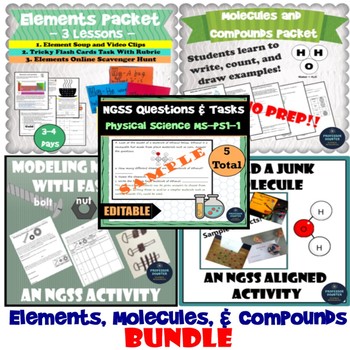Elements Molecules and Compounds Worksheets Activities NGSS Bundle MS-PS1-1
- Zip
Products in this Bundle (5)
Bonus
Description
This NGSS for middle school bundle is newly updated as a digital PDFs for home or distance learning and includes all 5 of my atoms, elements, compounds, and molecules lessons aligned to MS-PS1-1 and TEKS 6.5A. These activities provide instruction for up to two weeks at a discounted price and include fun and engaging activities such as Tricky Flash Cards and the Junk Compound Project! You will have access to over 37 pages of resources that are sure to engage and challenge your students thinking about elements, molecules, and compounds.
If using as a distance learning resource, simply print and assign worksheets or attach to Google Classroom (or whatever platform you use!) Check out the other home/distance learning products in my store! Home and Distance Learning Resources
I have included my best selling NGSS Unit Template (EDITABLE) as a bonus resource for FREE!!!
This set of resources is aligned to the following standards:
NGSS Performance Expectation MS-PS1-1 Develop models to describe the atomic composition of simple molecules and extended structures
Texas TEKS 6.5A Know that an element is a pure substance represented by a chemical symbol and that a compound is a pure substance represented by a chemical formula
Students will:
- learn what elements are and their connection to atoms, the symbols/ abbreviations of 20 by making “Tricky Flash Cards”, and research basic facts about each in a Scavenger Hunt
- learn the difference between molecules and compounds, what they are, how to count the atoms, how to read and write chemical formulas, and how to draw model molecules
- use teacher's key to assemble and draw molecules out of nuts, bolts, and washers, research other molecules (or use teacher provided list) to create their own “system” for assembling molecules, create 3 new systems to build and draw molecules and relate molecules to mixtures (NOTE: THIS ACTIVITY MAY BE TOO DIFFICULT FOR DISTANCE LEARNING)
- find, research, and create simple molecules out of junk from home
- are challenged and assessed on all MS-PS1-1 through assessment tasks and questions which can be used on pre-assessments, tests, quizzes, or for check-ins!
Please see individual product titles and descriptions
Looking for assessments for MS-PS1 standards?
MS-PS1-2 Chemical Reactions Assessment Questions
MS-PS1-3 Synthetic/Natural Resources Assessment Questions
MS-PS1-4 Modeling Adding/Removing Heat Assessment Questions
MS-LS1-5 Conservation of Mass Assessment Questions
If you want ALL of the MS-LS1 Matter and Its Interactions Assessments Questions, click here! MS-PS1 Assessment Questions (Includes ideas for design challenge MS-LS1-6)
Looking for assessment resources for more NGSS standards? Check out my other Assessments here: NGSS Assessments and Test Questions
Check back for more NGSS Assessments for Physical, Life, and Earth Sciences!
Let’s Connect!
Follow my store at this link to stay up-to-date on my latest NGSS resources! Click here!
Are you on Facebook? Be sure to follow me on Facebook for NGSS FREEBIES, updates on what I’m working on, and of course, science memes! Professor Doubter's Facebook Page
Interested in other NGSS aligned physical science products? Check out the links below:
Crosscutting Concepts Lab Stations
Synthetic and Natural Resources STEM Project
Prevent a Chemical Change With Pennies Lab
Magnetic Fields and Eating Nails For Breakfast Lab
Modeling Particle Motion, State, and Temperature Lab
Physical and Chemical Changes Minilabs
Dry Ice Demonstration on Sublimation
Potential and Kinetic Energy Worksheet
Modeling Compounds and Molecules with Fasteners
Rutherford's Discovery of the Nucleus Lab (FREE)
States of Matter Metaphors
Introduction to Waves Activity
Properties of Waves PowerPoint and Foldable
Modeling Reflection of Light Lab
Electromagnetic Spectrum Activity
NGSS Unit Template for Planning (Example Included)
***Buy the "Waves" Bundle and save $$ here: Waves Bundle
Looking for other NGSS lessons, units, activities, etc.? Check out my store for more here: Store Link.
Buy the bundle to have access to all NGSS resources!
NGSS Physical Science Bundle: Click Here
NGSS Life Science Bundle: Click Here
NGSS Earth Science Bundle: Click Here
NGSS All Resources Bundle: Click Here
Feel free to share my website with colleagues. Each purchase is a license for ONE person to use in a classroom setting per my Terms of Use. Distribution or sharing of any products, or copy/pasting and reselling parts or whole of this product are in violation of copyright law.
If you like it, rate me!
If you love it, follow me here: Get the Goods
Also check out my other awesome NGSS lessons in my store AND BE SURE TO FOLLOW ME TO STAY UP-TO-DATE ON MY LATEST RESOURCES!!!!





